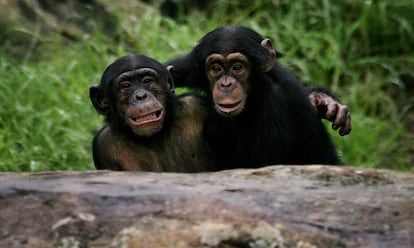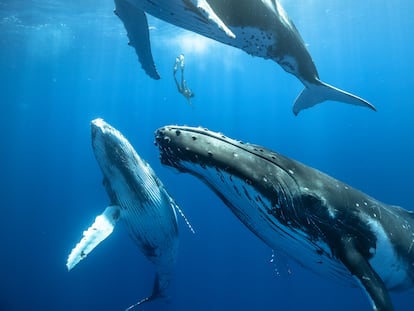Bees and chimpanzees can learn socially, just like humans
Two experiments have revealed that these animals can acquire behaviors from other members of their same species, which would allow for cultural accumulation

Primates have culture; that has been recognized for years. One example can be found among the groups of orangutans that live on both banks of the Kapuas River, on the island of Borneo (Indonesia). Almost 500 feet wide, the waterway is impossible to cross for these animals, which have developed very different diets on the two shores. Although all the individuals of each society eat practically the same thing, when comparing sides, the foods vary by 60%. These cultural habits can be transmitted from generation to generation with astonishing fidelity: in Panin, in the Ivory Coast, archaeological evidence has been found that 4,000 years ago the chimpanzees from that region used to open nuts with the same type of stones that their descendants use now. In Brazil, similar remains have been found, showing that a population of capuchin monkeys has been opening cashew nuts with the same tools for more than seven centuries.
As part of a scientific path that is leading to the recognition of increasingly sophisticated capabilities in animals, an article published recently in the Nature Human Behaviour journal examines their capacity for cumulative cultural evolution, a characteristic of humans. “Something as simple as a metal paper clip to hold some papers is only possible thanks to our capacity for cumulative cultural evolution. There is probably no one on the planet today with all the knowledge necessary to produce a paper clip, from extracting the minerals to everything else. This knowledge is distributed among many people, and has been accumulated over many generations,” explains Josep Call, a primatologist at the University of St Andrews in the UK and co-author of the study.
So far, it is proposed that, although chimpanzees learn from their environment things like what to eat or how to crack an almond, given a little time, they could have developed these abilities on their own. However, they would not be able to learn new techniques beyond their abilities, something necessary to accumulate complex knowledge that, in the long term, would allow them to create objects far beyond the capabilities of a single individual — such as a metal paper clip.
To find out if chimpanzees can learn complex processes beyond their individual abilities, the researchers tested 66 of these animals, which had to interact with a type of vending machine that required several steps before presenting a reward in the form of peanuts. They needed to take a wooden ball, pull a drawer, keep it open, put the ball inside and then close it to release the peanuts. For three months, the chimpanzees tried unsuccessfully to solve the enigma. Then, after the humans taught two chimpanzees the procedure and they showed off their skills in front of the others, 14 more were able to get the peanuts. They had learned it from their peers.
Even if it is not definitive proof, the results show that they can learn specific behaviors that are beyond their reach, which would give them the capacity to continue accumulating innovations and pass them on to other generations, although for now this cultural accumulation has not been seen in nature.
Chimpanzees are the closest living animals to us, and their behaviors can be interpreted as a living fossil with which to reconstruct the history of the human mind, but social learning does not seem to be a result of the late stages of evolution. In an article published this week in the journal Nature, a group of researchers showed that bumblebees can also acquire skills, which they do not develop on their own even if they are allowed to try for a while by watching others do it. In an experiment similar to that of the chimpanzees, a group of bumblebees faced a test that offered a sweet reward. Although they were not able to solve the puzzle by themselves, after some bumblebees were trained to pass the test and showed their skills to their peers, others began to carry out all the necessary tasks in the correct sequence to obtain the prize.
No bee behaviors that are considered cultural have been observed in nature, which makes researchers wonder why a capacity with so much potential appeared if it is not used. Alice Bridges, a researcher at the University of Sheffield (United Kingdom) and lead author of the article, states that the absence of evidence that bumblebees have a cumulative culture does not mean that it does not exist. “It is possible that an important part of their behavior, which we generally consider innate, could have some cultural component that we have not identified because we have not looked for it and we have assumed it to be innate and simple because we assume that insects are simple,” she says. Another possibility would be that, although bumblebees have the ability to solve problems, learn socially, or show flexible behavior because it is useful for their daily lives, they do not use those skills to build a culture because they simply have no need. “For example, you wouldn’t expect bees, cumulative culture or not, to start building cars or bicycles like humans, because they can already fly,” says Bridges.
Although the experiments suggest that the ability to learn difficult tasks, which is the basis of cumulative culture, seems to be shared by all kinds of animals, it is evident that humans developed it exceptionally well. Perhaps at some point in human evolutionary history our ancestors faced circumstances in which cultural accumulation favored their survival. Now, in addition to accumulating small innovations, Homo sapiens makes revolutionary changes, such as the transition from internal combustion cars to electric vehicles. “They are both solutions for transportation, but the system is completely different,” explains Call. “We have not yet found that type of radical, revolutionary change in chimpanzees.”
Something interesting in the incorporation of innovations is the role of exceptional individuals, those who are capable of doing things for the first time, which will later be incorporated into common culture. These types of minds, who are responsible for a large number of novelties and which have been observed among several species of primates, are rare, and their new ways may not always be welcome. “Culture is a curious thing, because it arises from the tension between two forces, between the drive to keep doing things as they have always been done — otherwise they are not passed on and there is no culture — and the force that allows changes to be introduced, adopted and alter the culture. It is a clash between those who advocate changes, and non-change,” says Call. Without delving into this newfound animal ability, it seems that, as was previously the case with the use of tools, intentional communication or the ability to recall memories of the past, it is no longer an exclusive trait of humans.
Sign up for our weekly newsletter to get more English-language news coverage from EL PAÍS USA Edition
Tu suscripción se está usando en otro dispositivo
¿Quieres añadir otro usuario a tu suscripción?
Si continúas leyendo en este dispositivo, no se podrá leer en el otro.
FlechaTu suscripción se está usando en otro dispositivo y solo puedes acceder a EL PAÍS desde un dispositivo a la vez.
Si quieres compartir tu cuenta, cambia tu suscripción a la modalidad Premium, así podrás añadir otro usuario. Cada uno accederá con su propia cuenta de email, lo que os permitirá personalizar vuestra experiencia en EL PAÍS.
¿Tienes una suscripción de empresa? Accede aquí para contratar más cuentas.
En el caso de no saber quién está usando tu cuenta, te recomendamos cambiar tu contraseña aquí.
Si decides continuar compartiendo tu cuenta, este mensaje se mostrará en tu dispositivo y en el de la otra persona que está usando tu cuenta de forma indefinida, afectando a tu experiencia de lectura. Puedes consultar aquí los términos y condiciones de la suscripción digital.











































